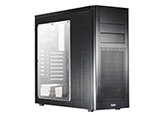FtroopDad’s Computer Case Buyer’s Guide:
Whether you are building a new computer or updating an existing one, the computer case is one of the most important pieces of hardware to consider, yet many times important aspects of the case are overlooked. Looks, cooling, functionality, noise, and price are important considerations when selecting a case, but there are several other attributes that often go unnoticed until problems arise after the system is built and money is spent. I hope you will find this guide useful as you consider the purchase of your next computer case.
Looks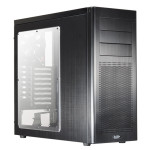
To some people this might be the most important criteria. What will my friends think when they see my new computer? Whether you want a computer that looks like something left here by extraterrestrial beings or a simple black box that no one notices, make a decision on what you want and stick to it. A windowed side panel may look good, but are there vents in it that disrupt the air flow you need or do you need to be able to install a fan there to maximize cooling? For those that keep there computer in their bedroom, fans with LED’s look cool, but will they keep you from sleeping? There have been studies on the effect of certain colored lights and sleep habits.
Cooling
Computers, like any other electrical device, produce heat. This is a natural law of physics and cannot be avoided. Electrons moving through a conductor produce heat. Heat is generated by the friction of moving parts such as fans and hard drive platters spinning. This heat is transferred to other components through direct contact and by the surrounding air absorbing the heat thus transferring the heat to components the warm air contacts. A good example is the CPU. As the CPU operates it generates heat, this heat is normally transferred to a block of metal attached to the CPU called a heatsink. As the surrounding air comes in contact with the heatsink, the air absorbs the heat and if the air is in motion it dissipates the heat to the atmosphere. This is why moving the warm air out of the case is so important. In the following paragraphs I will discuss the effects individual components have on the air flow in the computer case.
Positive or Negative Pressure: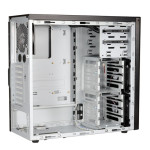 These are terms referring to the air in the case being pushed into the case faster than it leaves the case (positive pressure) or the air is pulled from the case faster than it enters the case (negative pressure). Too much positive pressure can cause heat to build up in the case as it is not being exhausted to the outside. Too much negative pressure can cause air to be drawn into the case uncontrolled (more on this later). There have been many debates as to which of these is preferred yet in today’s modern computers the air flow can fluctuate drastically depending on the current workload. As the temperature or workload change, so can the speed of the fans for the PSU, GPU, and CPU causing the pressure in the case to suddenly change. The case fans have no way of accurately knowing if more or less air needs to be moved in or out of the case. The ideal situation is to have enough air moving through the case to accommodate all needs. In the image to the right, notice two 140mm intake fans and one 120mm exhaust fan. The expansion slot covers are also vented to relieve access pressure.
These are terms referring to the air in the case being pushed into the case faster than it leaves the case (positive pressure) or the air is pulled from the case faster than it enters the case (negative pressure). Too much positive pressure can cause heat to build up in the case as it is not being exhausted to the outside. Too much negative pressure can cause air to be drawn into the case uncontrolled (more on this later). There have been many debates as to which of these is preferred yet in today’s modern computers the air flow can fluctuate drastically depending on the current workload. As the temperature or workload change, so can the speed of the fans for the PSU, GPU, and CPU causing the pressure in the case to suddenly change. The case fans have no way of accurately knowing if more or less air needs to be moved in or out of the case. The ideal situation is to have enough air moving through the case to accommodate all needs. In the image to the right, notice two 140mm intake fans and one 120mm exhaust fan. The expansion slot covers are also vented to relieve access pressure.
The CPU: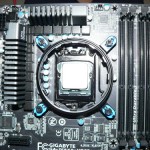 Most modern CPU’s (Central Processing Units or processors) come with a fan and heatsink assembly. The fan moves air across a heatsink attached to the CPU and subsequently this air helps cool the electrical components on the motherboard surrounding the CPU. It is very important that the many transistors and capacitors surrounding the CPU socket get cooled. This is why many upscale motherboards have heatsinks covering these devices to draw off the heat. If you deviate from the original design by using an aftermarket CPU cooler and especially an all-in-one liquid cooling system, make sure there is still air circulation in this area of the motherboard. The resulting warm air needs to be removed from the case. This is most often accomplished by a rear case fan exhausting the air from the case. Providing cool air to the CPU area can be done by an air duct on the side panel of the case or adequate venting in the front of the case allowing cool air to replace the warm air exhausted by the rear case fan. If the case has a front door that hides the optical drives and covers the front intake fans, it should have plenty of vents for air flow. This is especially important if you plan to upgrade the intake fans as the vents may be designed for a fan with a specific amount of air flow. A fan with a higher CFM may be restricted defeating the purpose of the upgrade.
Most modern CPU’s (Central Processing Units or processors) come with a fan and heatsink assembly. The fan moves air across a heatsink attached to the CPU and subsequently this air helps cool the electrical components on the motherboard surrounding the CPU. It is very important that the many transistors and capacitors surrounding the CPU socket get cooled. This is why many upscale motherboards have heatsinks covering these devices to draw off the heat. If you deviate from the original design by using an aftermarket CPU cooler and especially an all-in-one liquid cooling system, make sure there is still air circulation in this area of the motherboard. The resulting warm air needs to be removed from the case. This is most often accomplished by a rear case fan exhausting the air from the case. Providing cool air to the CPU area can be done by an air duct on the side panel of the case or adequate venting in the front of the case allowing cool air to replace the warm air exhausted by the rear case fan. If the case has a front door that hides the optical drives and covers the front intake fans, it should have plenty of vents for air flow. This is especially important if you plan to upgrade the intake fans as the vents may be designed for a fan with a specific amount of air flow. A fan with a higher CFM may be restricted defeating the purpose of the upgrade.
The PSU: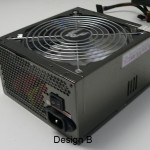
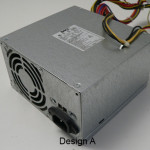 Most modern PSU’s (Power Supply Units) have some form of fan attached to move air across the electrical components inside. There are basically two designs that I will call Design A and Design B. Design A utilizes an 80mm fan inside the PSU that pulls air from inside the case across its internal components and exhausts it to the outside of the case. Design B uses a larger fan to push air across its internal components and exhausts it to the outside of the case. There are variants on each of these designs, but you should get the idea here. You may have noticed the trend towards computer cases having the PSU mounted in the bottom rather than the top of the case and the Design B PSU’s being more popular than Design A PSU’s. Basically a Design A PSU can be mounted in either location as it really has very little impact on other components. The Design B PSU needs unrestricted airflow and therefore caution should be used in its mounting. Most cases designed for a bottom mounted PSU have a vent in the bottom of the case so cool outside air is provided to the PSU. There are exceptions to this so be very careful. I have seen some builders install the Design B PSU with the fan up so it pulls air from inside the case. I personally do not care for this as I would rather have cool air from under the case and not have the PSU compete with other devices for air. I have seen a Design B PSU installed in the top of the case with the fan down so it pulls air from directly over the CPU. I would prefer not drawing hot air into the PSU therefore shortening its life. In my humble opinion this is just dumb. The cabling from the PSU should be hidden behind the motherboard tray if possible. Cables run in the open can deflect air flow from critical areas and it just looks bad.
Most modern PSU’s (Power Supply Units) have some form of fan attached to move air across the electrical components inside. There are basically two designs that I will call Design A and Design B. Design A utilizes an 80mm fan inside the PSU that pulls air from inside the case across its internal components and exhausts it to the outside of the case. Design B uses a larger fan to push air across its internal components and exhausts it to the outside of the case. There are variants on each of these designs, but you should get the idea here. You may have noticed the trend towards computer cases having the PSU mounted in the bottom rather than the top of the case and the Design B PSU’s being more popular than Design A PSU’s. Basically a Design A PSU can be mounted in either location as it really has very little impact on other components. The Design B PSU needs unrestricted airflow and therefore caution should be used in its mounting. Most cases designed for a bottom mounted PSU have a vent in the bottom of the case so cool outside air is provided to the PSU. There are exceptions to this so be very careful. I have seen some builders install the Design B PSU with the fan up so it pulls air from inside the case. I personally do not care for this as I would rather have cool air from under the case and not have the PSU compete with other devices for air. I have seen a Design B PSU installed in the top of the case with the fan down so it pulls air from directly over the CPU. I would prefer not drawing hot air into the PSU therefore shortening its life. In my humble opinion this is just dumb. The cabling from the PSU should be hidden behind the motherboard tray if possible. Cables run in the open can deflect air flow from critical areas and it just looks bad.
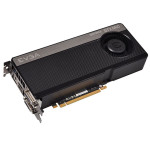
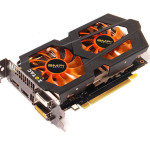 The GPU: This discussion is relevant to discreet GPU’s (Graphics Processing Units or video card), not video integrated into the motherboard or processor. There are two different designs of discreet GPU’s. Reference design refers to a GPU with a fan on the forward end of the circuit board that moves air across a heatsink and exhausts the air outside the computer case. Reference designed GPU’s need plenty of cool air, but because they exhaust most their air outside the case they have little impact on other components. Custom deigned GPU’s usually have one to three fans mounted to a heatsink resulting in most of the warm air being dispersed inside the case. As warm air rises, this warm air can have an impact on other components such as CPU or GPU. Removing this warm air is best done by exhaust fans in the side panel above the GPU and/or in the top of the case. Keep in mind that large fans mounted in the side panel can conflict with heat pipes protruding from some custom design GPU’s. Some custom design GPU’s can exceed 10.5 inches in length, so make sure the case has room. Removable HDD cages can remedy this problem quickly. Because the GPU is one of the largest suppliers of heat in a case, I prefer to use reference design GPU’s in my builds.
The GPU: This discussion is relevant to discreet GPU’s (Graphics Processing Units or video card), not video integrated into the motherboard or processor. There are two different designs of discreet GPU’s. Reference design refers to a GPU with a fan on the forward end of the circuit board that moves air across a heatsink and exhausts the air outside the computer case. Reference designed GPU’s need plenty of cool air, but because they exhaust most their air outside the case they have little impact on other components. Custom deigned GPU’s usually have one to three fans mounted to a heatsink resulting in most of the warm air being dispersed inside the case. As warm air rises, this warm air can have an impact on other components such as CPU or GPU. Removing this warm air is best done by exhaust fans in the side panel above the GPU and/or in the top of the case. Keep in mind that large fans mounted in the side panel can conflict with heat pipes protruding from some custom design GPU’s. Some custom design GPU’s can exceed 10.5 inches in length, so make sure the case has room. Removable HDD cages can remedy this problem quickly. Because the GPU is one of the largest suppliers of heat in a case, I prefer to use reference design GPU’s in my builds.
Functionality
So you find a computer case that looks great and has great air flow, but when you start to assemble your new computer you find some real problems. Make sure the case will function with the other components you selected. You would not want to try to put an extended motherboard in a mid sized tower, but there are other problems that may not be so obvious.
Dust and Filters: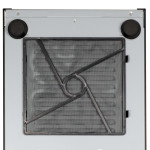
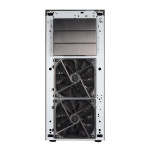 Dust accumulation in a computer can be destructive. When dust buildup is severe it can clog cooling fins on heatsinks, add additional weight to fan blades shortening their life and weakening the normal heat transferring properties of electrical components. In extremely humid environments the dust can absorb moisture and become conductive causing current flow where you don’t want it. I highly recommend using a case with intake filters (see the front fan filters and PSU filter pictured on the right), although this does make case selection and airflow a little more complicated. Negative pressure in the case when workload is heavy can cause air to be drawn in from non-filtered vents thus defeating the purpose of the filters. Consider using enough fans to create positive pressure with vented expansion slot covers to relieve excess pressure. This will insure all components get the air they need no matter the workload. I would stay away from cases that have open ports on top for audio, USB, hot swapping of drives, etc. These ports are dust magnets and have been known to fill with dust to the point of not being usable. If you do not need fans in the top of the case then do not purchase a case that has the vents for them. These will allow dust to settle into the case and also spoil the air flow.
Dust accumulation in a computer can be destructive. When dust buildup is severe it can clog cooling fins on heatsinks, add additional weight to fan blades shortening their life and weakening the normal heat transferring properties of electrical components. In extremely humid environments the dust can absorb moisture and become conductive causing current flow where you don’t want it. I highly recommend using a case with intake filters (see the front fan filters and PSU filter pictured on the right), although this does make case selection and airflow a little more complicated. Negative pressure in the case when workload is heavy can cause air to be drawn in from non-filtered vents thus defeating the purpose of the filters. Consider using enough fans to create positive pressure with vented expansion slot covers to relieve excess pressure. This will insure all components get the air they need no matter the workload. I would stay away from cases that have open ports on top for audio, USB, hot swapping of drives, etc. These ports are dust magnets and have been known to fill with dust to the point of not being usable. If you do not need fans in the top of the case then do not purchase a case that has the vents for them. These will allow dust to settle into the case and also spoil the air flow.
Case Size: Bigger is not always better. The faster you can move air in and out of the case, the cooler it will be. A smaller case takes less time to refresh the air than a larger one. Consider the following when purchasing a case with fans already installed. Did the case manufacturer make allowances for upgrading the fans and can you add additional fans if needed? Case fans are usually categorized by size (mm), speed (RPM), air flow (CFM) and noise (dBa). A 70mm fan running 2200 RPM (revolutions per minute) with airflow of 12.72 CFM (cubic feet per minute) may be as quiet (20 dBa) as a 200mm fan running 800 RPM with air flow of 125 CFM, but the difference will be the larger fan will move more cool air in and more hot air out. An average mid tower case may be only 1.75 cubic feet in size and an average full tower may be 2.82 cubic feet in size, so do the math.
Motherboard: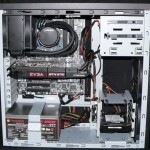 Make sure the stand-offs for the motherboard match the case. Some mid tower ATX cases will not provide the bolt arrangement for a Micro ATX motherboard. How hard will it be to plug the CPU power plug (4 pin or 8 pin) into the motherboard without having it openly cross the motherboard? Some motherboards have SATA2 and SATA3 connectors set flat on the motherboard. This is great for clearance under a long GPU, but the cable connections can conflict with support for the HDD cages. This can also be true for some USB3 ports. Some cases position the optical drive cage or the HDD cage so close to the motherboard tray that they actually interfere with each other. Some motherboards have large heatsinks attached over the voltage regulators around the CPU. These can conflict with fans mounted in the top of the case. In the image to the left, the motherboard fits perfectly with no conflicts at all.
Make sure the stand-offs for the motherboard match the case. Some mid tower ATX cases will not provide the bolt arrangement for a Micro ATX motherboard. How hard will it be to plug the CPU power plug (4 pin or 8 pin) into the motherboard without having it openly cross the motherboard? Some motherboards have SATA2 and SATA3 connectors set flat on the motherboard. This is great for clearance under a long GPU, but the cable connections can conflict with support for the HDD cages. This can also be true for some USB3 ports. Some cases position the optical drive cage or the HDD cage so close to the motherboard tray that they actually interfere with each other. Some motherboards have large heatsinks attached over the voltage regulators around the CPU. These can conflict with fans mounted in the top of the case. In the image to the left, the motherboard fits perfectly with no conflicts at all.
CPU Coolers: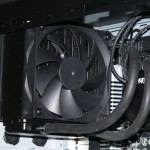 Make sure the case is deep enough if you plan to install an aftermarket CPU cooler known as a skyscraper. Some of these can be as tall as 165mm and your case of choice may only allow 160mm or less. If you are planning to install an all-in-one liquid cooling system for the CPU, make sure the fans and radiator will fit where the rear case fan would normally be located and not interfere with fans mounted in the top or side panel. If you install an all-in-one liquid cooling system radiator somewhere other than the where the rear case fan is normally positioned, keep in mind that you still need to cool the area around the CPU as mentioned earlier.
Make sure the case is deep enough if you plan to install an aftermarket CPU cooler known as a skyscraper. Some of these can be as tall as 165mm and your case of choice may only allow 160mm or less. If you are planning to install an all-in-one liquid cooling system for the CPU, make sure the fans and radiator will fit where the rear case fan would normally be located and not interfere with fans mounted in the top or side panel. If you install an all-in-one liquid cooling system radiator somewhere other than the where the rear case fan is normally positioned, keep in mind that you still need to cool the area around the CPU as mentioned earlier.
Noise
Noise should not be an issue with most modern computer cases. You should expect to here some CPU, GPU, and/or PSU fan noise when the workload is heavy. If a case fan is too loud for your taste, then replace it, they are inexpensive. Audible rattles and vibrations are unacceptable as this is an indication something is wrong. There are some aftermarket kits for lining the inside of the case to reduce noise, but some of these actually trap heat inside the case. The metal walls of the case dissipate some heat from the computer (especially an aluminum case), so if you insulate it for sound, you may have to sacrifice a cooler computer.
Price
You do not have to pay large amounts of money to get a good computer case. There are not that many computer case manufacturers. Start looking through the cases on Newegg.com. You will soon notice similarities, especially in the metal stampings of motherboard trays and rear panels. The difference will be primarily in the front bezel and side panels. Name recognition is not an indication of how well a case is built. Consider how the computer will be used, what components you plan to install now and in the future and make your own decision.
Closing Thoughts
I have tried very hard to not mention specific brands of computer cases as they share so many attributes it would mean nothing. You will have to decide for yourself what best suits your needs. It would be a good idea to visit a website like Newegg.com and peruse the many computer cases they offer. Read the Customer Reviews on the Feedback tab for each product you are interested in. This can give you incite as to problems found with specific cases. Go to the manufacturers page and you should find links to reviews from some of the renowned review websites or type the case name into your browser search followed by the word review and you should find plenty of reviews and opinions on the case you are interested in. Take your time and don’t rush, this is a very important investment. I will mention one manufacturer that incorporates many of the features that make a great computer case. Click the link and check out the computer cases made by Lian Li Lancool and compare these products to others on the market.
LIAN LI Lancool PC-K65
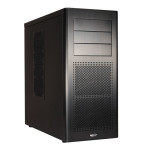
This has to be one of my favorite cases along with other members of this family. It has two filtered 140mm intake fans in front and a 120mm rear case fan. The PSU area has good venting and is also filtered. The upper HDD cage can be removed to allow the use of long GPU’s. The side panel has vents for additional fans that are initially blocked with removable panels. If addition ventilation is needed, just remove the appropriate panel. There are audio and USB ports mounted in the top cover, however they have a small cover to protect them when not in use. I personally use the PC-K9WX for my primary computer and have built several gaming systems with the PC-K57.
